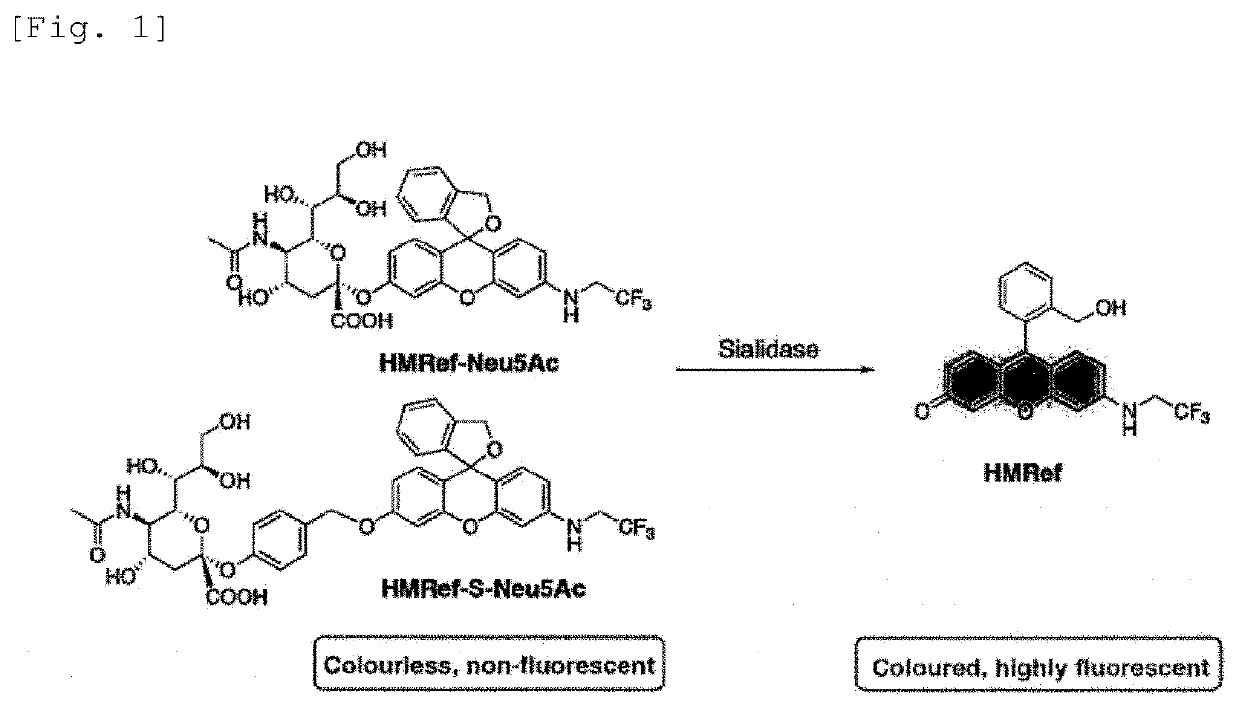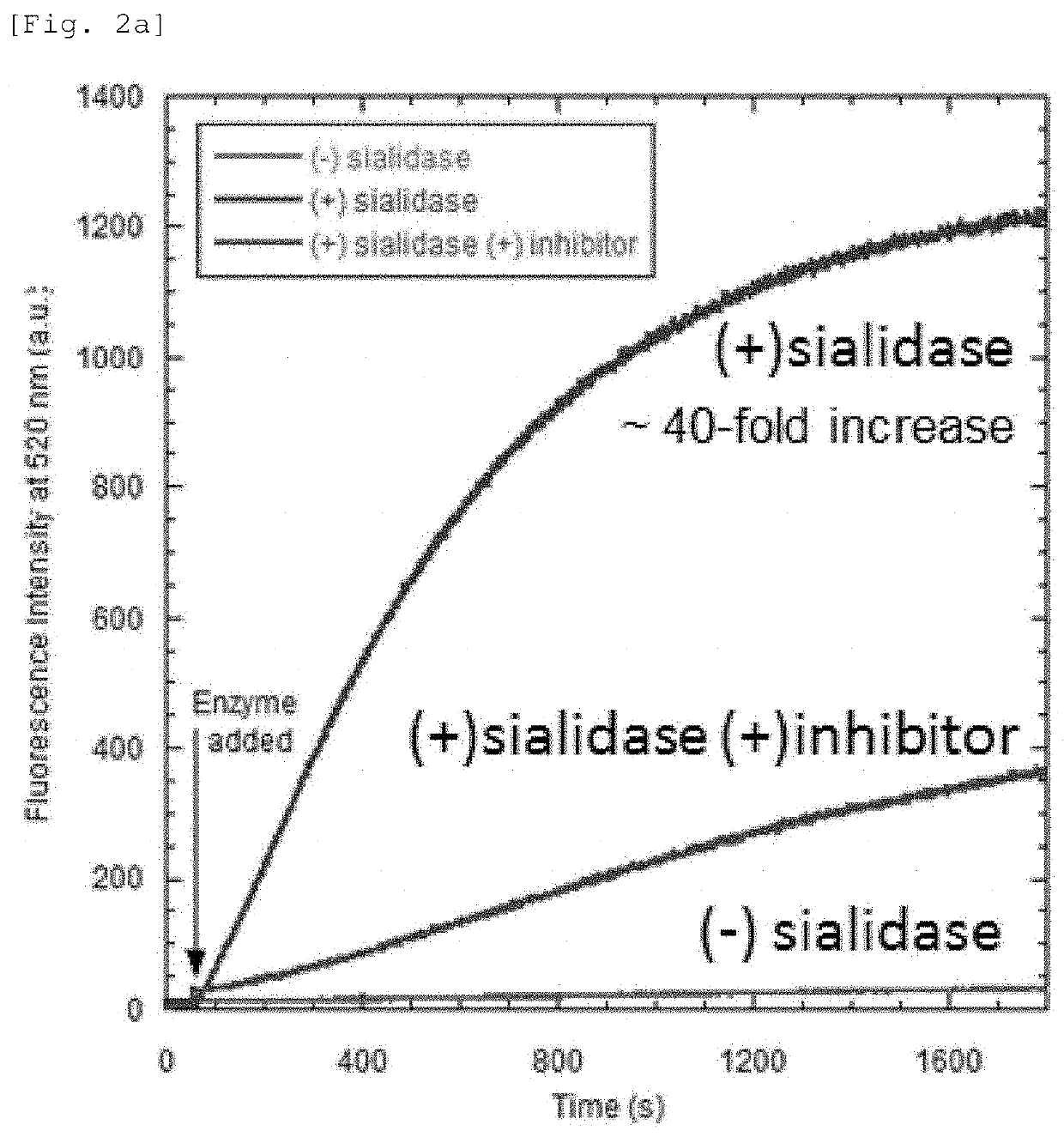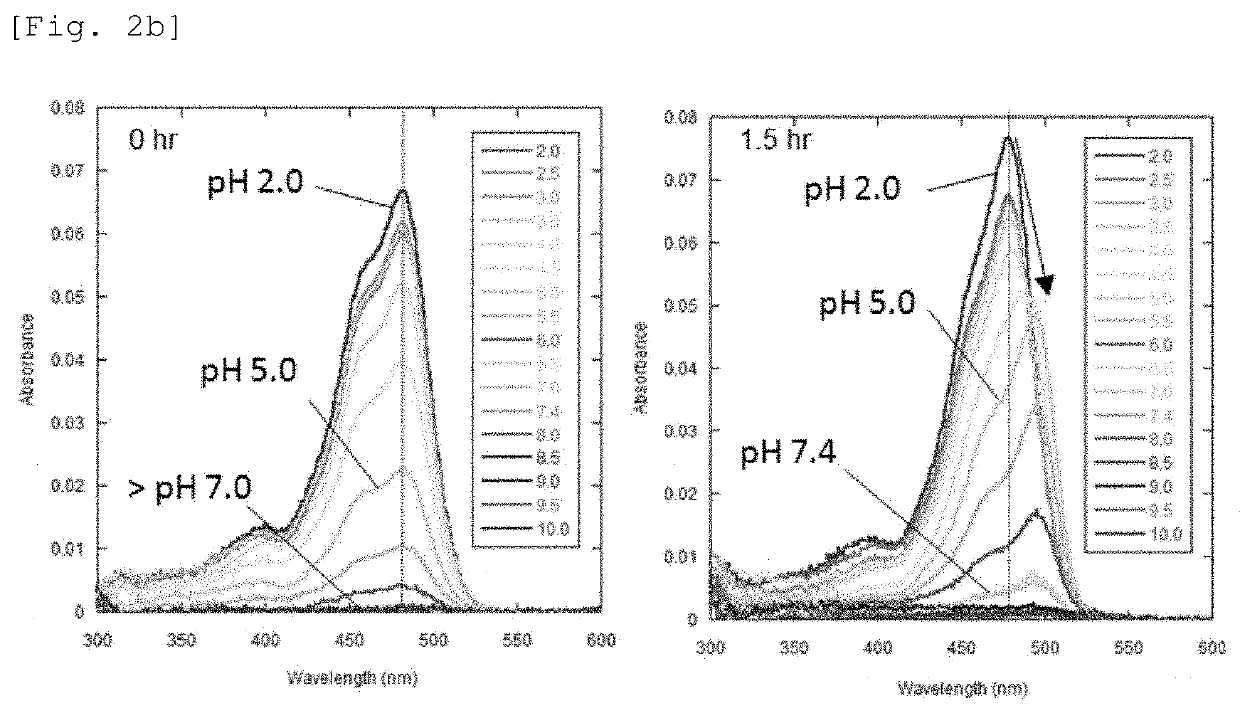Fluorescent probe for detecting activation of sialidase
a fluorescence probe and activity detection technology, applied in the field of fluorescent probes for detecting activity of sialidase, can solve the problems of only suitable probes, poor biocompatibility of all existing fluorescent probes for sialidase activity detection, and inability to perform in vivo fluorescence imaging, so as to improve the stability of compounds and high biocompatibility.
- Summary
- Abstract
- Description
- Claims
- Application Information
AI Technical Summary
Benefits of technology
Problems solved by technology
Method used
Image
Examples
synthesis example 1
[Synthesis Example 1]
[0094]Synthesis of HMRef-Neu5Ac
[0095]HMRef-Neu5Ac was synthesized in accordance with the procedure for the following reaction scheme.
[0096]HMRef was synthesized in accordance with the literature (D. Asanuma, M. Sakabe, M. Kamiya, K. Yamamoto, J. Hiratake, M. Ogawa, N. Kosaka, P. L. Choyke, T. Nagano, H. Kobayashi, Y. Urano, Nat. Commun., 2015, 6, 6463.). N-acetyl-2-chloro-2-dedineuraminic acid methyl ester 4,7,8,9-tetraacetate (393 mg, 0.77 mmol, 6.0 eq.), Ag2O (488 mg, 2.1 mmol, 16.4 eq.), NaI (150 mg, 1.0 mmol, 7.8 eq.), and a sufficient amount of anhydrous Na2SO4 were put into a flask, and HMRef (51.2 mg, 0.13 mmol, 1.0 eq.) dissolved in 20 mL of dry acetonitrile (MeCN) was added thereto. The reaction mixture was stirred at room temperature for 16 hours and then filtered, and the filtrate was distilled off under reduced pressure. The residue was dissolved in methanol (MeOH) (6 mL), and a 1 M NaOH aqueous solution (3 mL) was added. The mixture was stirred at r...
reference example 1
[0099]The fluorescence intensity of HMRef-Neu5Ac obtained in Synthesis Example 1 was changed through an enzymatic reaction with a neuraminidase (Arthrobacter ureafaciens), and the change in the fluorescence intensity of HMRef-Neu5Ac over time was examined. HMRef-Neu5Ac was dissolved in a 100 mM NaOAc 2 mM CaCl2 buffer (pH 7.4) to prepare a 1 μM solution, and 0.01 U of the enzyme was added 60 seconds after the start of measurement. At the time of measurement, the temperature was 37° C., and the concentration of an enzyme inhibitor (DANA) was 100 μM. FIG. 2a shows the results.
[0100]HMRef-Neu5Ac was dissolved in 0.2 M sodium phosphate buffers having various pH values, and the absorption spectra were measured immediately after and 1.5 hours after the dissolution. FIG. 2b shows the results.
[0101]At pH 7.4, HMRef-Neu5Ac preferentially takes the form of a spiro ring (pKcycl=4.8), and therefore almost no fluorescence was shown. When HMRef-Neu5Ac was reacted with the sialidase, a moderate in...
synthesis example 2
[0105]A compound 3 was synthesized in accordance with the procedure for the following reaction scheme.
[0106](1) Synthesis of Compound 1
[0107]To a solution of 4-hydroxybenzaldehyde (S, 479 mg, 3.9 mmol) and diisopropylethylamine (5 mL), an MeCN solution of N-acetyl-2-chloro-2-deoyzneuraminic acid methyl ester 4,7,8,9-tetraacetate 3 (0.5 mL, 3.1 mmol) was added, and the reaction mixture was stirred at room temperature for 3 hours. Then, all the solvent was removed, and the resulting residue was diluted with toluene (×3). The resulting residue was purified using silica gel chromatography (ethyl acetate (EtOAc):DCM, 1:1 to EtOAc) to obtain a compound 1 as white foam (145 mg, 62%).
[0108]1H NMR (400 MHz, CDCl3):δ1.93 (s, 3H, NHOAc), 2.05 (s, 3H, OAc), 2.06 (s, 3H, OAc), 2.12 (s, 3H, OAc), 2.19 (s, 3H, OAc), 2.30 (t, 1H, 3JHH=12.5 Hz, H3ax), 2.74 (dd, 1H, 3JHH=13, 4.7 Hz, H3eq), 3.65 (s, 3H, COOMe), 4.11 (m, 1H, H9), 4.13 (m, 1H, H5), 4.25 (dd, 1H, 3JHH =12.4, 2.4 Hz, H9′), 4.60 (dd, 1H, 3...
PUM
| Property | Measurement | Unit |
|---|---|---|
| emission wavelength | aaaaa | aaaaa |
| excitation wavelength | aaaaa | aaaaa |
| pH | aaaaa | aaaaa |
Abstract
Description
Claims
Application Information
 Login to View More
Login to View More - R&D
- Intellectual Property
- Life Sciences
- Materials
- Tech Scout
- Unparalleled Data Quality
- Higher Quality Content
- 60% Fewer Hallucinations
Browse by: Latest US Patents, China's latest patents, Technical Efficacy Thesaurus, Application Domain, Technology Topic, Popular Technical Reports.
© 2025 PatSnap. All rights reserved.Legal|Privacy policy|Modern Slavery Act Transparency Statement|Sitemap|About US| Contact US: help@patsnap.com



